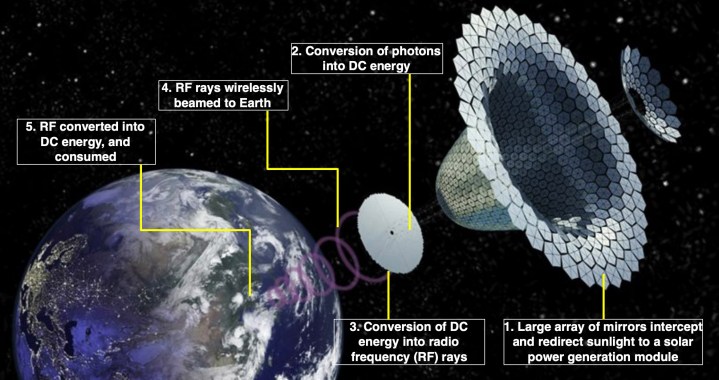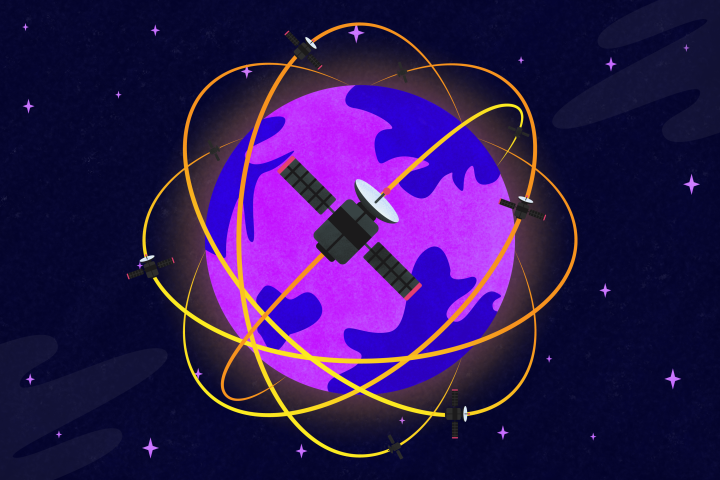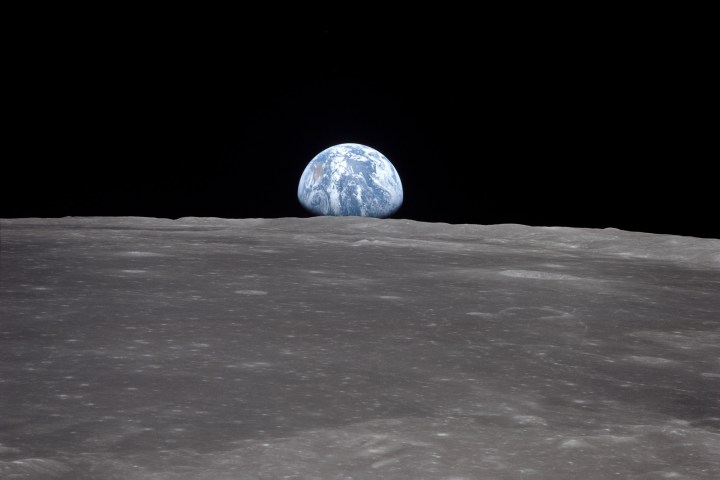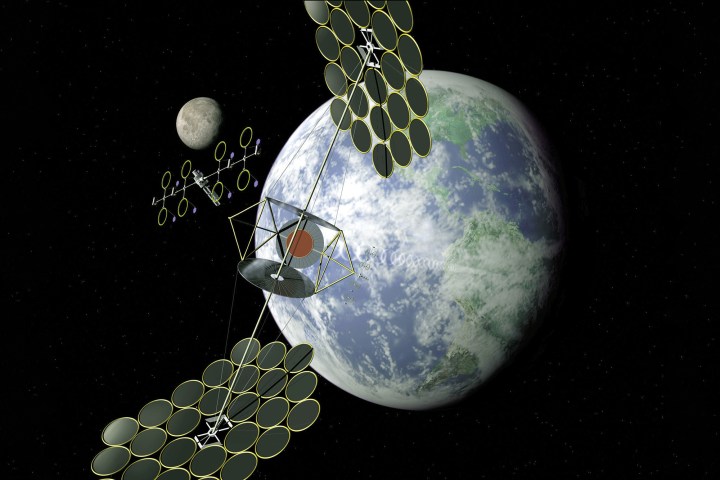It’s an idea straight out of science fiction: A space station orbits around Earth, harvesting energy from the sun and beaming it down to our planet. Isaac Asimov popularized the concept in his 1941 story Reason, and futurists have been dreaming about it ever since.
But this notion is more than just an idle fantasy — it’s a highly practical concept being pursued by space agencies across the world, and it’s almost within reach of current technologies. It could even be the solution to the energy crisis here on Earth.
We spoke to one of the people hoping to make this concept happen, Leopold Summerer, the head of the Advanced Concepts and Studies Office at the European Space Agency, to learn how we might go about turning this dream into a reality.
Building a better solar power station

Solar power has many advantages over fossil fuels or other energy sources: It’s freely available, renewable, has minimal environmental impacts, and is generally low maintenance. Plus, the technology in solar panels is getting better all the time, allowing them to harvest the energy coming from the sun more efficiently.
However, it’s not without its problems. One of the biggest issues is with storage, as energy can only be collected during daylight hours, and it needs to be stored in large batteries to provide power during the night. It’s also dependent on good weather, as cloud cover will reduce the amount of energy that can be collected.
If we could build a solar power station in space, though, we’d avoid these issues. Such a station could collect solar power 24 hours a day and wouldn’t need to store energy in bulky batteries. And if it were built in orbit, then it wouldn’t experience interference from the Earth’s atmosphere. The power could also be sent directly to where it’s needed most, such as large cities.
As fanciful as it sounds, the idea actually makes a lot of sense. “It is one of these concepts that looks at first, ‘Wow, really? Why would anybody put such large structures into space if you have enough free space on Earth?'” Summerer said. But on second glance, the concept has a lot of merit. “It addresses so many of our current challenges — from climate change to energy security — that it would be irresponsible not to consider it seriously,” he added.
Space makes sense
If an orbiting solar power station seems ridiculous, consider that it’s not so very different from the space technologies we already use. Summerer pointed out that many spacecraft operate using solar panels, so “we have solar power stations in space, we just use the power locally.”
To make a power station, we’d need much larger solar panels than those used on spacecraft, and we’d need to design the hardware to handle high voltages. But that should be a matter of incrementally improving on current technologies rather than having to create entirely new solutions.
The other half of the collection and distribution of power is the transfer issue. How would power be transferred from the station to Earth? This would require wireless power transfer using either lasers or microwaves. Such technologies have already been demonstrated on Earth, with power sent wirelessly over long distances — and if we can do it on Earth, we could do it in space.
Technological challenges

Of course, there’s nothing simple about building a power station and sending it into orbit. One of the big issues would be how to put a structure as large as a power station into orbit and how it would be maintained or fixed if anything went wrong. Many proponents of space-based solar power suggest starting with a constellation of satellites, which we know how to build and launch. If one goes wrong, then there are others that would continue to work. This way, we could learn about using the technology without putting our eggs into one massive, astronomically expensive basket.
There’s also the matter of efficiency. Current wireless power transmission technologies are only so efficient. For practical purposes, you’d likely want your solar power station in low Earth orbit, at perhaps 500 miles from the planet’s surface. We’d need to improve the efficiency of wireless power transmission and also make sure the station has a powerful enough antenna to send all the power it collects down to Earth.
The technology to do all of this isn’t ready yet — but it’s also not entirely out of our reach.
“It’s not that we can launch tomorrow,” Summerer explained. “But on the other hand, there’s nothing that anyone has identified which would be a showstopper for any of the key technologies that are required.”
A small, cooperative community
The challenges of a futuristic power system aren’t only technological, though. There’s also the problem of infrastructure. Even if we are able to harvest solar energy from space, we need infrastructure on Earth to distribute that power to where it’s needed. Who will bear this cost?
“It is a project that, almost by design, would strongly benefit from international cooperation,” Summerer said. Ideally, an international cooperation between different countries and their space agencies would pool resources to develop and launch the technology together, but that might prove hard when two of the biggest players in this area — the U.S. and China — don’t cooperate on space missions currently.
The cooperation is happening on an entirely voluntary basis.
However, Summerer sees reason to be optimistic about international cooperation in this arena, given that it’s in everyone’s interest to develop clean, renewable energy sources. There’s a model for this kind of cooperation in ITER, a cooperative international project researching the energy-generating potential of nuclear fusion projects.
When it comes to space-based solar power, “we’re not yet at the stage where we have one common international project with intergovernmental agreements for cooperation,” Summerer said, so “the cooperation is happening on an entirely voluntary basis.” But the community of nations researching the concept, including the U.S., China, Europe, and India, is small, and “we know each other pretty well” and “we have strong incentives to work together” to exchange ideas and technologies, he added.
The European Space Agency recently signed contracts for two concept studies into space-based solar power, with the aim of investigating how feasible the concept would be under the SOLARIS initiative. There could be a decision on whether to seriously pursue the idea as early as 2025.
The moon as a steppingstone

One promising venue for testing a newly developed power system might surprise you. Rather than sending power from space to Earth, we could test a system by first sending power from space to the moon.
In many ways, it’s actually easier to transmit power to the moon than to Earth.
By setting up a system to collect solar power in space and transmit it to the moon’s surface, “you can demonstrate practically all the key technologies” for a similar system for sending power to Earth, Summerer said.
It also makes sense, given the plans of NASA and other organizations to build long-term habitats on the moon that will require constant power. “We need power on the moon for any larger installation, and the sources on the moon are very limited,” Summerer said. The lunar nights are cold and long, lasting around two weeks, so we’ll need a power source that can sustain visitors during this period. Nuclear and solar are the two practical options for this, so there’s already a lot of focus on developing these systems for future missions.
In many ways, it’s actually easier to transmit power to the moon than to Earth. The moon has no atmosphere or cloud cover to get in the way of power transmission. And power requirements would be far lower for a lunar base than they would be for Earth.
So, if we need to test space-based solar power solutions and we need power for lunar missions, why not combine the two? “The moon might well be a stepping stone to develop the key technologies to demonstrate how [space-based solar power] works on a much smaller scale,” Summerer said.
Closer than you think

All of this talk of progressing technology and future developments might have you imagining that such a system is decades away. But experts like Summerer believe we could see space-based solar power working far sooner than that.
“An in-orbit demonstration is feasible relatively quickly,” Summerer said, depending on the size of the system. He thinks that a demonstration system, intended to test the technology but not actually provide usable power, could be developed within just five years.
As for when we might see such technology in practical use, some people on Earth might be using power from a small space-based solar system by the mid-2030s.
That’ll be just in time for the 100-year anniversary of the publication of Asimov’s story. A century to take a concept from fanciful science fiction to concrete scientific reality? That’s not a bad timeline for doing the impossible.



